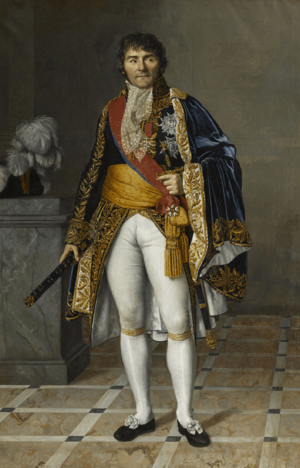François Joseph Lefebvre facts for kids
François Joseph Lefebvre was a famous French military leader. He lived from 1755 to 1820. He fought in the French Revolutionary Wars and the Napoleonic Wars. Napoleon made him one of his top commanders, called a Marshal of the Empire. He was also known as the Duke of Danzig.
Contents
Early Life and Family
François Joseph Lefebvre was born in Rouffach, Alsace, France. His father was a soldier called a hussar. At age 17, Lefebvre joined the French Army. He was a big supporter of the French Revolution.
In 1783, he married Cathérine Hübscher. They had 14 children together, but sadly, all of them passed away before him.
Rise During the Revolution
In 1789, Lefebvre was a sergeant in the French Guards. When this group was disbanded, he joined the National Guard. He was even wounded while protecting the Royal Family from an angry crowd. After this, he fully joined the revolution.
He quickly rose through the ranks. In 1793, he became a brigadier general. He fought in important battles like the Battle of Fleurus in 1794. Later, he commanded a large army called the Army of Sambre-et-Meuse.
In 1799, he led the front lines of the Army of the Danube. He was injured in the Battle of Ostrach. In November 1799, Lefebvre was in charge of the troops in Paris. He helped Napoleon Bonaparte in his coup d'état, which was a sudden takeover of the government. After this, Napoleon made him a senator in 1800.
Serving Napoleon
Napoleon made Lefebvre a Marshal of the Empire in 1804. This was a very high military rank. In 1805, Lefebvre commanded a part of Napoleon's elite troops, the Old Guard.
At the Battle of Jena-Auerstedt in 1806, he led the infantry of the Imperial Guard. In 1807, he led his army corps to besiege and capture the city of Danzig. Because of this victory, Napoleon gave him the title of Duke of Danzig.
In 1808, Lefebvre fought in the Peninsular War in Spain. In 1809, he commanded the Bavarian Army in battles like Eckmühl and Wagram. He also led the Old Guard during the French invasion of Russia in 1812, including the Battle of Borodino. He continued to fight in the German and French campaigns of 1813 and 1814.
Lefebvre later voted for Napoleon to be removed from power. When the French monarchy was restored, Louis XVIII made him a Peer of France. However, when Napoleon returned for a short time during the Hundred Days, Lefebvre supported him again.
Later Life and Legacy
After Napoleon's final defeat, Lefebvre was removed from the Chamber of Peers. But he kept his high rank as a marshal. In 1819, Louis XVIII restored his peerage.
François Joseph Lefebvre passed away in 1820. He was buried near another famous marshal, André Masséna, at the Père-Lachaise Cemetery in Paris.
Lefebvre never forgot his humble beginnings and the hard work it took to achieve his success. He once told a friend who envied his wealth, "I had a thousand bullets shot at me from much closer range before I got all this." This showed how much he had risked and fought for his position.
Images for kids
See also




